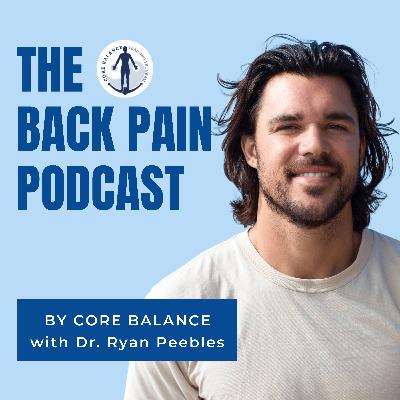In this episode, Dr. Ryan Peebles, Doctor of Physical Therapy and founder of Core Balance Training, breaks down anterior vs. posterior pelvic tilt, how these patterns influence your spine, discs, and nerves, and what it really means to find neutral alignment.
You’ll learn how to test your own pelvic position, why sitting weakens your glutes and abs, and how subtle adjustments in how you move can begin reversing years of chronic pain. Dr. Ryan also answers live questions from students about posture, lifting safely, epidurals, and restoring confidence in movement.
This episode covers:
The anatomy of pelvic tilt: why your pelvis naturally isn’t flat
How anterior tilt compresses the back of the discs, creating nerve pressure
Why posterior tilt flattens the lumbar curve and can overstretch tissues
A simple test to identify your tilt type
Glutes and abs vs. tight hip flexors
How sitting shapes your posture
When to bias a posterior tilt safely without overcorrecting
The “anchor triad” system for finding neutral and supporting your spine
Building lasting strength and confidence in your movement
Watch the free Core Balance Masterclass and start your 7-day free trial to experience the Back Anchor lesson firsthand and begin restoring your natural core support.
⚠️ Disclaimer: All content is for educational purposes only. Always consult a qualified healthcare professional before attempting any exercise program.
Episode Chapters: Pelvic Tilt & Back Pain
00:00:00 – Welcome & Ryan’s story: overcoming a decade of back pain 00:02:30 – What is pelvic tilt? Beyond just “anterior” and “posterior” 00:05:30 – Anatomy of tilt: how hips and spine interact 00:08:00 – Anterior tilt: nerve compression and “arched back” posture 00:11:30 – Posterior tilt: flat back, stretched ligaments, and pain patterns 00:14:00 – Why “neutral” is ideal and extremes cause repetitive trauma 00:18:30 – Sitting, weak glutes, and inhibited abs: the predictable imbalance 00:22:00 – Correcting tilt safely: activating the right muscles 00:26:00 – The 80/20 rule: why most people live in anterior tilt 00:30:00 – Self-tests: Shavasana, bolster method, and identifying your tilt 00:36:30 – Lifting and posture: when posterior tilt helps and when it hurts 00:41:00 – Core Balance Training explained: the three anchors system 00:47:00 – Q&A: disc issues, degenerative changes, and long-term hope 00:53:00 – Epidurals, PT, and learning to move with confidence 00:58:00 – Building lifelong support: why “life after Core Balance” is the real program 01:02:00 – Closing message: reconnecting with your body and regaining freedom






